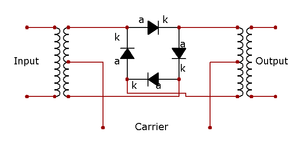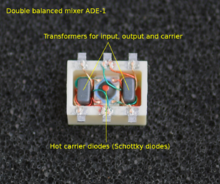Ring modulation


Ring modulation is a signal-processing effect in electronics, an implementation of amplitude modulation or frequency mixing, performed by multiplying two signals, where one is typically a sine-wave or another simple waveform. It is referred to as "ring" modulation because the analog circuit of diodes originally used to implement this technique took the shape of a ring.[1] This circuit is similar to a bridge rectifier, except that instead of the diodes facing "left" or "right", they go "clockwise" or "anti-clockwise". A ring modulator is an effects unit working on this principle.
The carrier, which is AC, at a given time, makes one pair of diodes conduct, and reverse-biases the other pair. The conducting pair carry the signal from the left transformer secondary to the primary of the transformer at the right. If the left carrier terminal is positive, the top and bottom diodes conduct. If that terminal is negative, then the "side" diodes conduct, but create a polarity inversion between the transformers. This action is much like that of a DPDT switch wired for reversing connections.
Examples
These are some audio samples of the ring modulation effect:
Operation

Ring modulators frequency mix or heterodyne two waveforms, and output the sum and difference of the frequencies present in each waveform. This process of ring modulation produces a signal rich in partials. As well, neither the carrier nor the incoming signal are prominent in the outputs, and ideally, not at all.
Two oscillators, whose frequencies were harmonically related and ring modulated against each other, produce sounds that still adhere to the harmonic partials of the notes, but contain a very different spectral make up. When the oscillators' frequencies are not harmonically related, ring modulation creates inharmonics, often producing bell-like or otherwise metallic sounds.
If the same signal is sent to both inputs of a ring modulator, the resultant harmonic spectrum is the original frequency domain doubled (if f1 = f2 = f, then f2 − f1 = 0 and f2 + f1 = 2f). Regarded as multiplication, this operation amounts to squaring. However, some distortion occurs due to the forward voltage drop of the diodes.
Some modern ring modulators are implemented using digital signal processing techniques by simply multiplying the time domain signals, producing a nearly-perfect signal output. Before digital music synthesizers became common, at least some analog synthesizers (such as the ARP 2600) used analog multipliers for this purpose; they were closely related to those used in electronic analog computers. (The "ring modulator" in the ARP 2600 could multiply control voltages; it could work at DC.)
Multiplication in the time domain is the same as convolution in the frequency domain, so the output waveform contains the sum and difference of the input frequencies. Thus, in the basic case where two sine waves of frequencies f1 and f2 (f1 < f2) are multiplied, two new sine waves are created, with one at f1 + f2 and the other at f2 - f1. The two new waves are unlikely to be harmonically related and (in a well designed ring modulator) the original signals are not present. It is this that gives the ring modulator its unique tones.
Intermodulation products can be generated by carefully selecting and changing the frequency of the two input waveforms. If the signals are processed digitally, the frequency-domain convolution becomes circular convolution. If the signals are wideband, this will cause aliasing distortion, so it is common to oversample the operation or low-pass filter the signals prior to ring modulation.
One application is spectral inversion, typically of speech; a carrier frequency is chosen to be above the highest speech frequencies (which are low-pass filtered at, say, 3 kHz, for a carrier of perhaps 3.3 kHz), and the sum frequencies from the modulator are removed by more low-pass filtering. The remaining difference frequencies have an inverted spectrum—High frequencies become low, and vice versa.
Integrated circuit methods of ring modulation
On the C64 SID chip, ring modulation multiplies a triangle wave with a square wave.
On an ARP Odyssey synthesizer (and a few others from that era as well) the ring modulator is an XOR function (formed from two NAND gates) fed from the square wave outputs of the two oscillators. For the limited case of square or pulse wave signals, this is identical to true ring modulation.
Analog multiplier ICs (such as those made by Analog Devices) would work as ring modulators, of course with regard to such matters as their operating limits and scale factors. Use of multplier ICs means that the modulation products are largely confined to sum and difference frequency of inputs (unless the circuit is overdriven), rather than the much more complicated products of the rectifier circuit.
Use in music
One of the earliest musical instruments utilizing a ring modulator may be the Melochord (1947) built by Harald Bode. It was a two-tone melody keyboard instrument with foot controllers and later added a second keyboard for timbre control, featuring a white-noise generator, envelope controller, formant filters and ring modulators for harmonics.[2] The early Melochord was extensively used by Werner Meyer-Eppler in the early days of the electronic music studio at Bonn University.[3]
Werner Meyer-Eppler mentioned the musical application of ring modulator in his book "Elektrische Klangerzeugung", published in 1949[4] (also described in Elena Ungeheuer's book[5]). In 1951, he joined to the successive proposal on establishment of WDR Studio for Electronic Music in Cologne, and at the beginning of the studio, already ring modulator was equipped along with the sound sources and audio gadget including sine wave oscillators, noise generator, etc.[6] Then in 1953, the above-mentioned Melochord by Harald Bode, along with the Electronic Monochord by Friedrich Trautwein, was specifically commissioned by the WDR Studio to upgrade their synthesis modules,[7] and used by the Elektronische Musik group especially in the first half of 1950s.[3][8] Also Meyer-Eppler demonstrated his experiments in June 1953 in Delft.[9][verification needed] A ring-modulator was the major component used in Louis and Bebe Barron's music for the film Forbidden Planet (1956).
Meyer-Eppler's student, Stockhausen also used ring modulation in 1956 for some sounds in Gesang der Jünglinge and his realization score for Telemusik (1966) also calls for it. Indeed, whole compositions are based around it, such as Mixtur (1964), one of the first compositions for orchestra and live electronics, Mikrophonie II (1965, where the sounds of choral voices are modulated with a Hammond organ), Mantra (1970, where the sounds from two pianos are routed through ring modulators), and Licht-Bilder (2002) from Sonntag aus Licht, which ring-modulates flute and trumpet.[10][11][12]
One of the first products dedicated for music was the Bode Ring Modulator developed in 1961 by Harald Bode. Also in 1964 he developed the Bode Frequency Shifter, which produced a clearer sound by eliminating a side band.[13] These devices were designed to be controlled by voltage, for today's modern modular synthesizer architecture also advocated by him,[14] and these modules were licensed to R.A. Moog for their Moog modular synthesizers started in 1963-1964.[15] In 1963, Don Buchla included an optional ring modulator in his first modular synthesizer, the Model 100.[16] Also Tom Oberheim built a ring modulator unit for his musician friend in the late 1960s,[17][18] and it became an origin of Oberheim Electronics Music Modulator[19] and Maestro Ring Modulator,[20] one of the earliest ring modulator effect products for guitarists. The EMS VCS3, Synthi A and Yamaha CS-80 synthesizers also featured built-in ring modulators.
One of the best-known applications of the ring modulator may be its use by Brian Hodgson of the BBC Radiophonic Workshop to produce the distinctive voice of the Daleks and the Cybermen in the television series Doctor Who, starting in 1963.[21]
Other applications
Ring modulation has also been extensively used in radio receivers, for example to demodulate an FM stereo signal, and to down-convert microwave signals in mobile telephone and wireless networking systems. In this case, the circuit is sometimes called a "ring demodulator", one of many possible chopper circuits.[22][23] A ring modulator can be used to generate a double-sideband suppressed-carrier (DSB-SC) wave used in radio transmission.[24]
See also
References
- ^ Richard Orton, "Ring Modulator", The New Grove Dictionary of Music and Musicians, second edition, edited by Stanley Sadie and John Tyrrell (London: Macmillan Publishers, 2001): "the ring modulator takes its name from the characteristic ring formation of four diodes in its analog circuit."
- ^ Rebekkah Palov (July 2011), "Harald Bode — A Short Biography", eContact!, 13 (4), Canadian Electroacoustic Community
- ^ a b "The "Melochord" (1947–9)", The Keyboardmuseum Online, archived from the original on 2007-11-14 (description and history)
- ^ Werner Meyer-Eppler, Elektronische Klangerzeugung: Elektronische Musik und synthetische Sprache, (Bonn: Ferdinand Dümmlers, 1949)
- ^ Elena Ungeheuer, Wie die elektronische Musik "erfunden" wurde. Quellenstudie zu Werner Meyer-Epplers Entwurf zwischen 1949 und 1953, (Mainz, inter al.: Schott, 1992), p. 208, ISBN 3-7957-1891-0
- ^ Thom Holmes, Electronic and Experimental Music (second ed.), (New York: Routledge, 1985), p. 96, ISBN 0-203-42706-8 (Master e-book), ISBN 0-203-43926-0 (Adobe eReader), ISBN 0-415-93643-8 (hard cover), ISBN 0-415-93644-6 (pbk)
- ^ Tom Rhea (May 2004), "Harald Bode", Video History Project, Experimental Television Center, archived from the original on 2011-07-19 (also broken format page remains in here)
- ^ Marietta Morawska-Büngeler, Schwingende Elektronen: Eine Dokumentation über das Studio für Elektronische Musik des Westdeutschen Rundfunks in Köln, 1951–1986, Cologne-Rodenkirchen: P. J. Tonger Musikverlag, 1988, p. 13
- ^ Werner Meyer-Eppler, "Which Possibilities Exist for the Meaningful Application of Electronic Music Instruments?", Musical Acoustics, Proc. 1st International Congress on Acoustics (ICA-Congr.) Electro-Acoustics (Delft, 1953) [full citation needed] — features the Bode Melochord of the WDR Studio for Electronic Music in Cologne.
- ^ Ludger Brümmer, "Stockhausen on Electronics, 2004", Computer Music Journal 32, no. 4 (2008):10–16.
- ^ Karlheinz Stockhausen, "Electroacoustic Performance Practice", translated by Jerome Kohl, Perspectives of New Music 34, no. 1 (Winter, 1996): 74-105. Citation on 89.
- ^ Karlheinz Stockhausen, "Einführung"/"Introduction", English translation by Suzanne Stephens, in booklet accompanying Karlheinz Stockhausen, Licht-Bilder (3. Szene vom SONNTAG aus LICHT), 2-CD set, Stockhausen Gesamtausgabe/Complete Edition 68A–B (Kürten: Stockhausen-Verlag, 2005): 10 & 51
- ^ Harald Bode - A Lifetime for Sound (PDF), Harald Bode News, retrieved 2011-01-27
- ^ Harald Bode, "European Electronic Music Instrument Design", Journal of the Audio Engineering Society 9 (1961): 267.
- ^ Tom Rhea, Harald Bode Biography, (New York: Experimental Television Center Ltd, 2004), archived from the original on 2011-07-19 (also broken format page remains)
- ^ Buchla Electronic Musical Instruments - Historical Overview, Buchla & Associates, retrieved 2011-01-27
- ^
Thomas E. Oberheim, "A Ring Modulator Device for the Performing Musician", AES Convention 38 (May 1970)
{{citation}}: Cite has empty unknown parameter:|month=(help), No. 708 (G-4). - ^ "Session Transcript: Tom Oberheim", Red Bull Music Academy Barcelona 2008
- ^ Oberheim Music Modulator (photo). Edison Music Corporation.
- ^ Maestro RM-1A Ring Modulator, DiscoFreq's Effects Database
- ^ Jeremy Bentham, Doctor Who: The Early Years, (London: W.H. Allen, 1986), p. 127, ISBN 0-491-03612-4
- ^ Meikle, Hamish (2008). Modern Radar Systems. Artech House. p. 336. ISBN 978-1-59693-243-2.
- ^ Yadav, Abhishek (2008). Analog Communication System. Firewall Media. p. 83. ISBN 978-81-318-0319-6.
- ^ T G Thomas S Chandra Sekhar (2005). Communication Theory. Tata McGraw-Hill Education. p. 37. ISBN 978-0-07-059091-5.
External links
- Scott Lehman. "Effects Explained: Ring Modulation". Harmony Central. Archived from the original on 2005-12-01.

